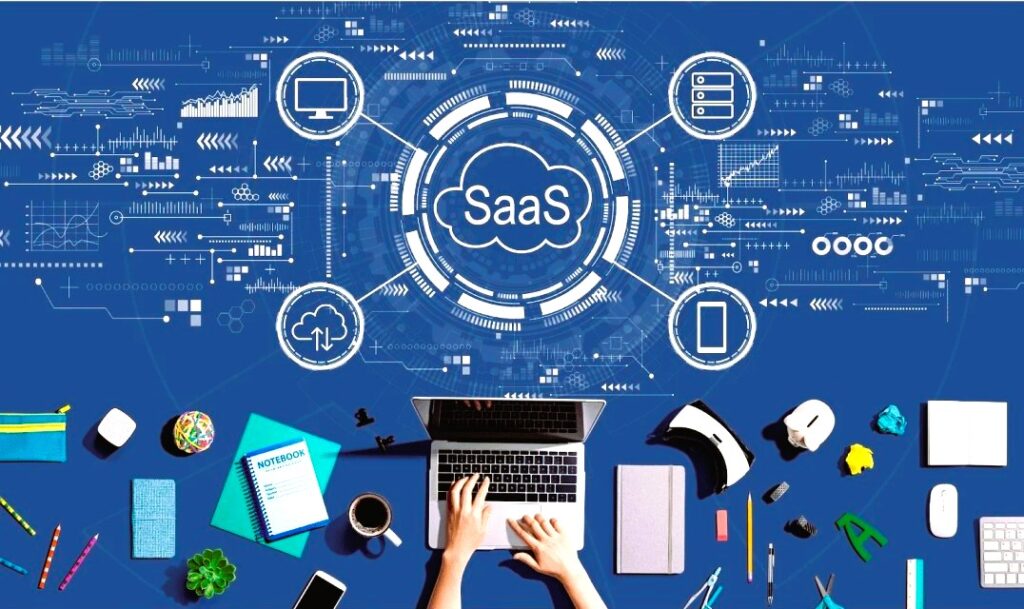What is SaaS-Benefits of SaaS for Small Business
What is the meaning of SaaS? Software as a Service (SaaS) is a cloud-based model that allows users to access applications over the Internet without requiring extensive local installations.
This approach offers numerous advantages, particularly for small businesses. They benefit from reduced upfront costs and many other benefits, which we discuss below in detail. SaaS typically operates on a subscription basis, allowing for predictable budgeting.
However, potential disadvantages include dependency on internet connectivity and concerns regarding data security. Balancing these factors is crucial for small enterprises considering SaaS solutions in today’s digital landscape.

You’ll Also Like These Post
Core SaaS Benefits and Disadvantages
| Benefits of SaaS | Disadvantages of SaaS |
| Accessibility from Anywhere | Dependence on Internet Connectivity |
| Lower Initial Costs | Limited Customization Options |
| Automatic Updates and Maintenance | Potential for Subscription Costs to Add Up |
| Scalability to Meet Business Needs | |
| Collaboration Features for Teams |
Benefits of SaaS for small business
- Accessibility from Anywhere: SaaS applications are accessible through the Internet, allowing employees to work from anywhere, whether in the office or remotely. This flexibility can enhance productivity and facilitate remote work.
- Lower Initial Costs: SaaS typically operates on a subscription model, which means small businesses can avoid hefty upfront costs associated with purchasing software licenses and hardware. This model allows for more predictable budgeting and financial planning.
- Automatic Updates and Maintenance: SaaS providers handle all updates and maintenance, ensuring that businesses always use the latest software version without additional costs or downtime. This relieves small businesses from the burden of managing software updates.
- Scalability to Meet Business Needs: SaaS solutions can easily scale up or down based on the changing needs of a business. Small businesses can start with a basic plan and upgrade as they grow, ensuring they only pay for what they need.
- Collaboration Features for Teams: Many SaaS applications include built-in collaboration tools that facilitate employee communication and teamwork. This can enhance productivity and streamline workflows, especially in remote or hybrid work environments.
- Ease of Integration: SaaS applications often integrate seamlessly with other software and services, allowing small businesses to create a cohesive technology ecosystem without significant hassle.
- Reduced IT Burden: Small businesses can reduce the need for extensive in-house IT support by outsourcing software management to a SaaS provider. This allows them to focus their resources on core business functions rather than managing software infrastructure.
- Trial Availability: Many SaaS providers offer free trials or freemium versions of their products, allowing small businesses to test the software before committing to a subscription. This reduces the risks associated with new software investments.
- Enhanced Security Features: Reputable SaaS providers invest in security measures and protocols to protect user data. For small businesses that may not have the resources to implement strong security measures, this can provide peace of mind.
- Faster Deployment: SaaS solutions can be deployed faster than traditional software installations. This rapid deployment allows small businesses to use the software almost immediately, helping them stay agile in dynamic markets.
These are some from the enormous benefits of saas for small business. By leveraging these benefits, small businesses can optimize operations, reduce costs, and remain competitive in an increasingly digital marketplace.
Frequently Asked Question
How does SaaS work?
Software as a Service (SaaS) is a cloud-based software delivery model where users access applications over the internet instead of installing them on local computers. SaaS providers host and maintain the infrastructure, security, and updates, allowing small businesses to use powerful software on a subscription basis without managing servers or IT resources. All you need is an internet connection and a browser or app login.
Examples of SaaS applications used by small businesses
Small businesses commonly use SaaS tools to manage various functions efficiently. Popular examples include:
QuickBooks Online – accounting and invoicing
Slack – team communication
HubSpot – CRM and marketing automation
Shopify – e-commerce store management
Trello – project and task management
Google Workspace – email, documents, and collaboration
Zoom – video conferencing and virtual meetings
These tools help streamline operations without large upfront investments in hardware or IT staff.
SaaS vs. traditional software: What’s the difference?
The main difference between SaaS and traditional software lies in delivery, updates, and cost structure:
Feature SaaS Traditional Software
Installation No installation needed Installed on local devices
Updates Automatic, cloud-based Manual, user-installed
Cost Subscription-based (monthly/yearly) One-time license fee
Access Anywhere with internet Limited to installed machines
Scalability Easily scalable Requires IT support to scale
SaaS is generally more flexible, cost-effective, and easier to manage for small businesses.
Cloud computing vs SaaS: What’s the difference?
Cloud computing refers to the overall delivery of computing services (servers, storage, databases, networking, etc.) over the internet. SaaS (Software as a Service) is a category within cloud computing focused specifically on delivering software applications via the web.
Cloud computing includes Infrastructure as a Service (IaaS), Platform as a Service (PaaS), and Software as a Service (SaaS).
SaaS is a ready-to-use software solution hosted in the cloud (e.g., Gmail, Zoom, Shopify).
In simple terms, SaaS is one way that cloud computing is used.
Best SaaS tools for small businesses in 2025
Here are some of the top-rated SaaS tools for small businesses in 2025, across different functions:
Accounting: QuickBooks Online, Xero
CRM: HubSpot, Zoho CRM
Project Management: Asana, Monday.com
Communication: Slack, Zoom
Marketing: Mailchimp, Canva Pro
E-Commerce: Shopify, WooCommerce (SaaS-hosted version)
HR & Payroll: Gusto, BambooHR
These tools are popular for their ease of use, scalability, and integrations with other platforms.
Where to buy SaaS solutions tailored to small businesses?
Small businesses can find and purchase SaaS solutions through:
Official provider websites (e.g., hubspot.com, shopify.com)
SaaS marketplaces like G2, Capterra, Appsumo and Product Hunt
Cloud marketplaces like AWS Marketplace, Microsoft AppSource, and Google Cloud Marketplace
Resellers and consultants who bundle SaaS with onboarding or training
Before purchasing, compare features, read user reviews, and test with a free trial when available.
How to get started with your first SaaS platform
Getting started with a SaaS platform is simple:
Identify your need (e.g., CRM, accounting, marketing automation)
Research options using comparison sites like Capterra or G2
Sign up for a free trial or freemium version
Set up your account and preferences – most platforms offer onboarding guides
Integrate with other tools (e.g., Google Workspace, Stripe, Slack)
Train your team using tutorials or vendor-provided support
Scale as you grow by upgrading plans or adding features
Most SaaS tools are user-friendly and require no technical background to begin.




